Osteogenic Differentiation of Mesenchymal Stem Cells Induced by Geometric Mechanotransductive 3D-Printed Poly-(L)-Lactic Acid Matrices
Abstract
1. Introduction
2. Results
2.1. Fabrication and Characterisation of 3D-Printed Scaffolds
2.1.1. Computer-Aided Design
2.1.2. Scanning Electron Microscopy
2.2. Immunofluorescence Imaging
2.3. Alkaline Phosphatase
2.4. Proteomics
2.4.1. Total Proteome Comparison of hADSC Seeded Scaffolds
2.4.2. Gene Ontology Analysis of Osteogenic-Related Proteins and Pathways
2.5. Protein Enrichment and Pathway Analysis
2.5.1. Gene Ontology Analysis of Mechanotransduction-Related Proteins and Pathways
2.5.2. Osteogenic Differentiation Stage Enrichment
2.5.3. Angiogenic Enrichment
3. Discussion
3.1. Mechanotransduction
3.2. Osteogenic Activity
3.2.1. Early-Stage Osteogenic Differentiation
3.2.2. Mid-Stage Osteogenic Differentiation
3.2.3. Late-Stage Osteogenic Differentiation
3.2.4. Angiogenesis-Osteogenesis Coupling
4. Materials and Methods
4.1. Computer-Aided Design Modelling of BTE Scaffolds
4.2. Scaffolds Manufactured with Fused Filament Fabrication
4.3. Cell Culture
4.4. Scaffold Seeding
4.5. Scaffold Sterilisation
4.6. Alkaline Phosphatase Assay
4.7. Fluoresence Imaging
4.7.1. Imaging Preparation
4.7.2. Imaging
4.7.3. Image Processing
4.7.4. Scanning Electron Microscopy Analysis
4.7.5. Protein Extraction
4.8. Sample Preparation
4.9. Liquid Chromatography–Tandem Mass Spectrometry
4.10. Database Search
4.11. Bioinformatic Analysis
Gene Ontologies (GOs)/Enrichment
4.12. Heatmaps
5. Conclusions
Supplementary Materials
Author Contributions
Funding
Institutional Review Board Statement
Informed Consent Statement
Data Availability Statement
Acknowledgments
Conflicts of Interest
References
- Xue, N.; Ding, X.; Huang, R.; Jiang, R.; Huang, H.; Pan, X.; Min, W.; Chen, J.; Duan, J.A.; Liu, P.; et al. Bone Tissue Engineering in the Treatment of Bone Defects. Pharmaceuticals 2022, 15, 879. [Google Scholar] [CrossRef] [PubMed]
- Abdelaziz, A.G.; Nageh, H.; Abdo, S.M.; Abdalla, M.S.; Amer, A.A.; Abdal-Hay, A.; Barhoum, A. A Review of 3D Polymeric Scaffolds for Bone Tissue Engineering: Principles, Fabrication Techniques, Immunomodulatory Roles, and Challenges. Bioengineering 2023, 10, 204. [Google Scholar] [CrossRef] [PubMed]
- Gan, Q.; Pan, H.; Zhang, W.; Yuan, Y.; Qian, J.; Liu, C. Fabrication and evaluation of a BMP-2/dexamethasone co-loaded gelatin sponge scaffold for rapid bone regeneration. Regen. Biomater. 2022, 9, rbac008. [Google Scholar] [CrossRef] [PubMed]
- Ferracini, R.; Herreros, M.I.; Russo, A.; Casalini, T.; Rossi, F.; Perale, G. Scaffolds as Structural Tools for Bone-Targeted Drug Delivery. Pharmaceutics 2018, 10, 122. [Google Scholar] [CrossRef]
- Grosso, A.; Burger, M.G.; Lunger, A.; Schaefer, D.J.; Banfi, A.; Di Maggio, N. It Takes Two to Tango: Coupling of Angiogenesis and Osteogenesis for Bone Regeneration. Front. Bioeng. Biotechnol. 2017, 5, 68. [Google Scholar] [CrossRef]
- Ribeiro, S.; Watigny, A.; Bayon, Y.; Biggs, M.; Zeugolis, D.I. It Takes Two to Tango: Controlling Human Mesenchymal Stromal Cell Response via Substrate Stiffness and Surface Topography. Adv. NanoBiomed Res. 2023, 4, 2300042. [Google Scholar] [CrossRef]
- Ferrai, C.; Schulte, C. Mechanotransduction in stem cells. Eur. J Cell Biol. 2024, 103, 151417. [Google Scholar] [CrossRef]
- Rotherham, M.; Nahar, T.; Broomhall, T.J.; Telling, N.D.; El Haj, A.J. Remote magnetic actuation of cell signalling for tissue engineering. Curr. Opin. Biomed. Eng. 2022, 24, 100410. [Google Scholar] [CrossRef]
- Engler, A.J.; Sen, S.; Sweeney, H.L.; Discher, D.E. Matrix elasticity directs stem cell lineage specification. Cell 2006, 126, 677–689. [Google Scholar] [CrossRef]
- Schamberger, B.; Ziege, R.; Anselme, K.; Ben Amar, M.; Bykowski, M.; Castro, A.P.G.; Cipitria, A.; Coles, R.A.; Dimova, R.; Eder, M.; et al. Curvature in Biological Systems: Its Quantification, Emergence, and Implications across the Scales. Adv. Mater. 2023, 35, e2206110. [Google Scholar] [CrossRef]
- Lin, X.; Romanazzo, S.; Lin, K.; Kelly, C.; Gooding, J.J.; Roohani, I. Elliptical supra-cellular topographies regulate stem cells migratory pattern and osteogenic differentiation. Materialia 2020, 14, 100870. [Google Scholar] [CrossRef]
- Callens, S.J.P.; Fan, D.; van Hengel, I.A.J.; Minneboo, M.; Diaz-Payno, P.J.; Stevens, M.M.; Fratila-Apachitei, L.E.; Zadpoor, A.A. Emergent collective organization of bone cells in complex curvature fields. Nat. Commun. 2023, 14, 855. [Google Scholar] [CrossRef] [PubMed]
- Liu, Y.; Wang, Y.; Lin, M.; Liu, H.; Pan, Y.; Wu, J.; Guo, Z.; Li, J.; Yan, B.; Zhou, H.; et al. Cellular Scale Curvature in Bioceramic Scaffolds Enhanced Bone Regeneration by Regulating Skeletal Stem Cells and Vascularization. Adv. Healthc. Mater. 2024, 13, e2401667. [Google Scholar] [CrossRef] [PubMed]
- Bidan, C.M.; Kommareddy, K.P.; Rumpler, M.; Kollmannsberger, P.; Fratzl, P.; Dunlop, J.W. Geometry as a factor for tissue growth: Towards shape optimization of tissue engineering scaffolds. Adv. Healthc. Mater. 2013, 2, 186–194. [Google Scholar] [CrossRef] [PubMed]
- Al-Ketan, O. MSLattice: A free software for generating uniform and graded lattices based on triply periodic minimal surfaces. Mater. Des. Process. Commun. 2021, 3, e205. [Google Scholar] [CrossRef]
- Ansari, S.; Ito, K.; Hofmann, S. Alkaline Phosphatase Activity of Serum Affects Osteogenic Differentiation Cultures. ACS Omega 2022, 7, 12724–12733. [Google Scholar] [CrossRef]
- Capulli, M.; Paone, R.; Rucci, N. Osteoblast and osteocyte: Games without frontiers. Arch. Biochem. Biophys. 2014, 561, 3–12. [Google Scholar] [CrossRef]
- Siffert, R.S. The role of alkaline phosphatase in osteogenesis. J. Exp. Med. 1950, 93, 415–426. [Google Scholar] [CrossRef]
- Diez-Escudero, A.; Andersson, B.; Persson, C.; Hailer, N.P. Hexagonal pore geometry and the presence of hydroxyapatite enhance deposition of mineralized bone matrix on additively manufactured polylactic acid scaffolds. Mater. Sci. Eng. C 2021, 125, 112091. [Google Scholar] [CrossRef]
- Li, S.; Yang, H.; Qu, X.; Qin, Y.; Liu, A.; Bao, G.; Huang, H.; Sun, C.; Dai, J.; Tan, J.; et al. Multiscale architecture design of 3D printed biodegradable Zn-based porous scaffolds for immunomodulatory osteogenesis. Nat. Commun. 2024, 15, 3131. [Google Scholar] [CrossRef]
- Luo, W.; Wang, Y.; Wang, Z.; Jiao, J.; Yu, T.; Jiang, W.; Li, M.; Zhang, H.; Gong, X.; Chao, B.; et al. Advanced topology of triply periodic minimal surface structure for osteogenic improvement within orthopedic metallic screw. Mater. Today Bio 2024, 27, 101118. [Google Scholar] [CrossRef]
- Karacan, I.; Milthorpe, B.; Ben-Nissan, B.; Santos, J. Stem Cells and Proteomics in Biomaterials and Biomedical Applications; Springer: Berlin/Heidelberg, Germany, 2022. [Google Scholar]
- Lanza, R. Principles of Tissue Engineering, 5th ed.; Academic Press: Cambridge, MA, USA, 2020. [Google Scholar]
- Wang, L.; Zheng, F.; Song, R.; Zhuang, L.; Yang, M.; Suo, J.; Li, L. Integrins in the Regulation of Mesenchymal Stem Cell Differentiation by Mechanical Signals. Stem Cell Rev. Rep. 2022, 18, 126–141. [Google Scholar] [CrossRef]
- Hamidouche, Z.; Fromigué, O.; Ringe, J.; Häupl, T.; Vaudin, P.; Pagès, J.C.; Srouji, S.; Livne, E.; Marie, P.J. Priming integrin α5 promotes human mesenchymal stromal cell osteoblast differentiation and osteogenesis. Proc. Natl. Acad. Sci. USA 2009, 106, 18587–18591. [Google Scholar] [CrossRef] [PubMed]
- Lee, H.M.; Seo, S.R.; Kim, J.; Kim, M.K.; Seo, H.; Kim, K.S.; Jang, Y.J.; Ryu, C.J. Expression dynamics of integrin alpha2, alpha3, and alphaV upon osteogenic differentiation of human mesenchymal stem cells. Stem Cell Res. Ther. 2020, 11, 210. [Google Scholar] [CrossRef] [PubMed]
- Liu, Y.; Yang, Q.; Wang, Y.; Lin, M.; Tong, Y.; Huang, H.; Yang, C.; Wu, J.; Tang, B.; Bai, J.; et al. Metallic Scaffold with Micron-Scale Geometrical Cues Promotes Osteogenesis and Angiogenesis via the ROCK/Myosin/YAP Pathway. ACS Biomater. Sci. Eng. 2022, 8, 3498–3514. [Google Scholar] [CrossRef] [PubMed]
- Uhler, C.; Shivashankar, G.V. Regulation of genome organization and gene expression by nuclear mechanotransduction. Nat. Rev. Mol. Cell Biol. 2017, 18, 717–727. [Google Scholar] [CrossRef]
- Werner, M.; Blanquer, S.B.; Haimi, S.P.; Korus, G.; Dunlop, J.W.; Duda, G.N.; Grijpma, D.W.; Petersen, A. Surface Curvature Differentially Regulates Stem Cell Migration and Differentiation via Altered Attachment Morphology and Nuclear Deformation. Adv. Sci. 2017, 4, 1600347. [Google Scholar] [CrossRef]
- Lu, Q.; Diao, J.; Wang, Y.; Feng, J.; Zeng, F.; Yang, Y.; Kuang, Y.; Zhao, N.; Wang, Y. 3D printed pore morphology mediates bone marrow stem cell behaviors via RhoA/ROCK2 signaling pathway for accelerating bone regeneration. Bioact. Mater. 2023, 26, 413–424. [Google Scholar] [CrossRef]
- Jiang, X.; Hu, J.; Wu, Z.; Cafarello, S.T.; Di Matteo, M.; Shen, Y.; Dong, X.; Adler, H.; Mazzone, M.; Ruiz de Almodovar, C.; et al. Protein Phosphatase 2A Mediates YAP Activation in Endothelial Cells Upon VEGF Stimulation and Matrix Stiffness. Front. Cell Dev. Biol. 2021, 9, 675562. [Google Scholar] [CrossRef]
- Wan, L.; Liu, F.; Wang, A.; He, Y.; Pan, J.; Liu, Y.; Xu, J.; Xu, C.; Wu, F.; Ye, Q. PI3K/Akt pathway-mediated enhancement of bone and vascular regeneration by gelatin/hyaluronic acid/exosome composite scaffold in bone tissue engineering. Biomater. Adv. 2025, 166, 214064. [Google Scholar] [CrossRef]
- Zhang, H.; Zhang, M.; Zhai, D.; Qin, C.; Wang, Y.; Ma, J.; Zhuang, H.; Shi, Z.; Wang, L.; Wu, C. Polyhedron-Like Biomaterials for Innervated and Vascularized Bone Regeneration. Adv. Mater. 2023, 35, e2302716. [Google Scholar] [CrossRef]
- Hu, L.; Chen, W.; Qian, A.; Li, Y.P. Wnt/beta-catenin signaling components and mechanisms in bone formation, homeostasis, and disease. Bone Res. 2024, 12, 39. [Google Scholar] [CrossRef]
- Zhu, S.; Chen, W.; Masson, A.; Li, Y.P. Cell signaling and transcriptional regulation of osteoblast lineage commitment, differentiation, bone formation, and homeostasis. Cell Discov. 2024, 10, 71. [Google Scholar] [CrossRef]
- Yang, Y.; Xu, T.; Bei, H.P.; Zhang, L.; Tang, C.Y.; Zhang, M.; Xu, C.; Bian, L.; Yeung, K.W.; Fuh, J.Y.H.; et al. Gaussian curvature-driven direction of cell fate toward osteogenesis with triply periodic minimal surface scaffolds. Proc. Natl. Acad. Sci. USA 2022, 119, e2206684119. [Google Scholar] [CrossRef]
- Golhin, A.P.; Tonello, R.; Frisvad, J.R.; Grammatikos, S.; Strandlie, A. Surface roughness of as-printed polymers: A comprehensive review. Int. J. Adv. Manuf. Technol. 2023, 127, 987–1043. [Google Scholar] [CrossRef]
- Rezaei, A.; Izadi, R.; Fantuzzi, N. A Hierarchical Nano to Micro Scale Modelling of 3D Printed Nano-Reinforced Polylactic Acid: Micropolar Modelling and Molecular Dynamics Simulation. Nanomaterials 2024, 14, 1113. [Google Scholar] [CrossRef]
- Werner, M.; Petersen, A.; Kurniawan, N.A.; Bouten, C.V.C. Cell-Perceived Substrate Curvature Dynamically Coordinates the Direction, Speed, and Persistence of Stromal Cell Migration. Adv. Biosyst. 2019, 3, e1900080. [Google Scholar] [CrossRef] [PubMed]
- Frey, K.; Brunner, M.; Curio, C.; Kemkemer, R. Curvature Perception of Mesenchymal Cells on Mesoscale Topographies. Adv. Heal Mater. 2024, 14, e2402865. [Google Scholar] [CrossRef] [PubMed]
- Lužanin, O.; Gudurić, V.; Bernhardt, A.; Movrin, D.; Damjanović-Vasilić, L.; Terek, P.; Ostojić, G.; Stankovski, S. Impact of In-Process Crystallinity of Biodegradable Scaffolds Fabricated by Material Extrusion on the Micro- and Nanosurface Topography, Viability, Proliferation, and Differentiation of Human Mesenchymal Stromal Cells. Polymers 2023, 15, 1468. [Google Scholar] [CrossRef]
- Liu, Q.; Wei, F.; Coathup, M.; Shen, W.; Wu, D. Effect of Porosity and Pore Shape on the Mechanical and Biological Properties of Additively Manufactured Bone Scaffolds. Adv. Healthc. Mater. 2023, 12, e2301111. [Google Scholar] [CrossRef]
- Yuan, X.; Cao, J.; He, X.; Serra, R.; Qu, J.; Cao, X.; Yang, S. Ciliary IFT80 balances canonical versus non-canonical hedgehog signalling for osteoblast differentiation. Nat. Commun. 2016, 7, 11024. [Google Scholar] [CrossRef]
- Li, Z.; Wu, Z.; Xi, X.; Zhao, F.; Liu, H.; Liu, D. Cellular communication network factor 1 interlinks autophagy and ERK signaling to promote osteogenesis of periodontal ligament stem cells. J. Periodontal Res. 2022, 57, 1169–1182. [Google Scholar] [CrossRef]
- Cheng, Y.; Chen, J.; Zou, S.; Huang, L.; Li, G. The mechanism underlying the remodeling effect of lactoferrin on midpalatal sutures during maxillary expansion and relapse in rats. Am. J. Orthod. Dentofac. Orthop. 2023, 163, e137–e151. [Google Scholar] [CrossRef] [PubMed]
- Liu, J.; He, S.; Ma, B.; Li, X.; Wang, Y.; Xiong, J. TMT-based quantitative proteomic analysis revealed that FBLN2 and NPR3 are involved in the early osteogenic differentiation of mesenchymal stem cells (MSCs). Aging 2023, 15, 7637–7654. [Google Scholar] [CrossRef] [PubMed]
- Mizuhashi, K.; Kanamoto, T.; Ito, M.; Moriishi, T.; Muranishi, Y.; Omori, Y.; Terada, K.; Komori, T.; Furukawa, T. OBIF, an osteoblast induction factor, plays an essential role in bone formation in association with osteoblastogenesis. Dev. Growth Differ. 2012, 54, 474–480. [Google Scholar] [CrossRef] [PubMed]
- Tanaka, K.; Inoue, Y.; Hendy, G.N.; Canaff, L.; Katagiri, T.; Kitazawa, R.; Komori, T.; Sugimoto, T.; Seino, S.; Kaji, H. Interaction of Tmem119 and the bone morphogenetic protein pathway in the commitment of myoblastic into osteoblastic cells. Bone 2012, 51, 158–167. [Google Scholar] [CrossRef]
- Xu, K.; Huang, R.Q.; Wen, R.M.; Yao, T.T.; Cao, Y.; Chang, B.; Cheng, Y.; Yi, X.J. Annexin A family: A new perspective on the regulation of bone metabolism. Biomed. Pharmacother. 2024, 178, 117271. [Google Scholar] [CrossRef]
- Wang, Y.K.; Weng, H.K.; Mo, F.E. The regulation and functions of the matricellular CCN proteins induced by shear stress. J. Cell Commun. Signal. 2023, 17, 361–370. [Google Scholar] [CrossRef]
- Zhao, G.; Huang, B.L.; Rigueur, D.; Wang, W.; Bhoot, C.; Charles, K.R.; Baek, J.; Mohan, S.; Jiang, J.; Lyons, K.M. CYR61/CCN1 Regulates Sclerostin Levels and Bone Maintenance. J. Bone Miner. Res. 2018, 33, 1076–1089. [Google Scholar] [CrossRef]
- Grey, A.; Banovic, T.; Zhu, Q.; Watson, M.; Callon, K.; Palmano, K.; Ross, J.; Naot, D.; Reid, I.R.; Cornish, J. The Low-Density Lipoprotein Receptor-Related Protein 1 Is a Mitogenic Receptor for Lactoferrin in Osteoblastic Cells. Mol. Endocrinol. 2004, 18, 2268–2278. [Google Scholar] [CrossRef]
- Koushik, T.M.; Miller, C.M.; Antunes, E. Bone Tissue Engineering Scaffolds: Function of Multi-Material Hierarchically Structured Scaffolds. Adv. Healthc. Mater. 2023, 12, e2202766. [Google Scholar] [CrossRef]
- Wang, H.; Parry, S.; Macones, G.; Sammel, M.D.; Kuivaniemi, H.; Tromp, G.; Argyropoulos, G.; Halder, I.; Shriver, M.D.; Romero, R.; et al. A Functional SNP in the Promoter of the SERPINH1 Gene Increases Risk of Preterm Premature Rupture of Membranes in African Americans. Proc. Natl. Acad. Sci. USA 2006, 103, 13463–13467. [Google Scholar] [CrossRef]
- Wewer, U.M.; Ibaraki, K.; Schjørring, P.; Durkin, M.E.; Young, M.F.; Albrechtsen, R. A potential role for tetranectin in mineralization during osteogenesis. J. Cell Biol. 1994, 127, 1767–1775. [Google Scholar] [CrossRef] [PubMed]
- Gorski, J.P.; Hankenson, K.D. Secreted noncollagenous proteins of bone. In Principles of Bone Biology; Academic Press: Cambridge, MA, USA, 2020; pp. 359–378. [Google Scholar]
- Liu, Z.; Wang, Q.; Zhang, J.; Qi, S.; Duan, Y.; Li, C. The Mechanotransduction Signaling Pathways in the Regulation of Osteogenesis. Int. J. Mol. Sci. 2023, 24, 14326. [Google Scholar] [CrossRef]
- Faure, E.; Busso, N.; Nasi, S. Roles of Lysyl oxidases (LOX(L)) in pathologic calcification. Biomed. Pharmacother. 2024, 181, 117719. [Google Scholar] [CrossRef]
- Zou, M.L.; Chen, Z.H.; Teng, Y.Y.; Liu, S.Y.; Jia, Y.; Zhang, K.W.; Sun, Z.L.; Wu, J.J.; Yuan, Z.D.; Feng, Y.; et al. The Smad Dependent TGF-beta and BMP Signaling Pathway in Bone Remodeling and Therapies. Front. Mol. Biosci. 2021, 8, 593310. [Google Scholar] [CrossRef]
- Park, J.S.; Kim, M.; Song, N.J.; Kim, J.H.; Seo, D.; Lee, J.H.; Jung, S.M.; Lee, J.Y.; Lee, J.; Lee, Y.S.; et al. A Reciprocal Role of the Smad4-Taz Axis in Osteogenesis and Adipogenesis of Mesenchymal Stem Cells. Stem Cells 2019, 37, 368–381. [Google Scholar] [CrossRef]
- Beattie, J.; Al-Khafaji, H.; Noer, P.R.; Alkharobi, H.E.; Alhodhodi, A.; Meade, J.; El-Gendy, R.; Oxvig, C. Insulin- like Growth Factor-Binding Protein Action in Bone Tissue: A Key Role for Pregnancy- Associated Plasma Protein-A. Front. Endocrinol. 2018, 9, 31. [Google Scholar] [CrossRef]
- Zhang, Y.; Ling, L.; Ajay, D.O.A.A.; Eio, Y.M.; van Wijnen, A.J.; Nurcombe, V.; Cool, S.M. FGFR2 accommodates osteogenic cell fate determination in human mesenchymal stem cells. Gene 2022, 818, 146199. [Google Scholar] [CrossRef]
- Su, N.; Jin, M.; Chen, L. Role of FGF/FGFR signaling in skeletal development and homeostasis: Learning from mouse models. Bone Res. 2014, 2, 14003. [Google Scholar] [CrossRef]
- Li, J.; Wang, Z.; Huang, X.; Wang, Z.; Chen, Z.; Wang, R.; Chen, Z.; Liu, W.; Wu, B.; Fang, F.; et al. Dynamic proteomic profiling of human periodontal ligament stem cells during osteogenic differentiation. Stem Cell Res. Ther. 2021, 12, 98. [Google Scholar] [CrossRef]
- Drabek, K.; van de Peppel, J.; Eijken, M.; van Leeuwen, J.P. GPM6B regulates osteoblast function and induction of mineralization by controlling cytoskeleton and matrix vesicle release. J. Bone Miner. Res. 2011, 26, 2045–2051. [Google Scholar] [CrossRef] [PubMed]
- Bleier, M.; Yuskiv, N.; Priest, T.; Moisa Popurs, M.A.; Stockler-Ipsiroglu, S. Morquio B patient/caregiver survey: First insight into the natural course of a rare GLB1 related condition. Mol. Genet. Metab. Rep. 2018, 16, 57–63. [Google Scholar] [CrossRef] [PubMed]
- Ishida, K.; Acharya, C.; Christiansen, B.A.; Yik, J.H.; DiCesare, P.E.; Haudenschild, D.R. Cartilage oligomeric matrix protein enhances osteogenesis by directly binding and activating bone morphogenetic protein-2. Bone 2013, 55, 23–35. [Google Scholar] [CrossRef] [PubMed]
- Grosso, A.; Lunger, A.; Burger, M.G.; Briquez, P.S.; Mai, F.; Hubbell, J.A.; Schaefer, D.J.; Banfi, A.; Di Maggio, N. VEGF dose controls the coupling of angiogenesis and osteogenesis in engineered bone. Npj Regen. Med. 2023, 8, 15. [Google Scholar] [CrossRef]
- Khademhosseini, A.; Langer, R. A decade of progress in tissue engineering. Nat. Protoc. 2016, 11, 1775–1781. [Google Scholar] [CrossRef]
- Newby, D.; Marks, L.; Lyall, F. Dissolved oxygen concentration in culture medium: Assumptions and pitfalls. Placenta 2005, 26, 353–357. [Google Scholar] [CrossRef]
- Zhao, B.; He, J.; Wang, F.; Xing, R.; Sun, B.; Zhou, Y. Polyacrylamide-Sodium Alginate Hydrogel Releasing Oxygen and Vitamin C Promotes Bone Regeneration in Rat Skull Defects. Front. Mater. 2021, 8, 758599. [Google Scholar] [CrossRef]
- Li, Y.; Li, J.; Jiang, S.; Zhong, C.; Zhao, C.; Jiao, Y.; Shen, J.; Chen, H.; Ye, M.; Zhou, J.; et al. The design of strut/TPMS-based pore geometries in bioceramic scaffolds guiding osteogenesis and angiogenesis in bone regeneration. Mater. Today Bio 2023, 20, 100667. [Google Scholar] [CrossRef]
- Lin, F.; Zhang, W.; Xue, D.; Zhu, T.; Li, J.; Chen, E.; Yao, X.; Pan, Z. Signaling pathways involved in the effects of HMGB1 on mesenchymal stem cell migration and osteoblastic differentiation. Int. J. Mol. Med. 2016, 37, 789–797. [Google Scholar] [CrossRef]
- Lv, Y.; Lin, C. High mobility group box 1-immobilized nanofibrous scaffold enhances vascularization, osteogenesis and stem cell recruitment. J. Mater Chem. B 2016, 4, 5002–5014. [Google Scholar] [CrossRef]
- Rossi, E.; Bernabeu, C.; Smadja, D.M. Endoglin as an Adhesion Molecule in Mature and Progenitor Endothelial Cells: A Function Beyond TGF-beta. Front. Med. 2019, 6, 10. [Google Scholar] [CrossRef]
- Nassiri, F.; Cusimano, M.D.; Scheithauer, B.W.; Rotondo, F.; Fazio, A.; Yousef, G.M.; Syro, L.V.; Kovacs, K.; Lloyd, R.V. Endoglin (CD105): A Review of its Role in Angiogenesisand Tumor Diagnosis, Progression and Therapy. Anticancer Res. 2011, 31, 2283–2290. [Google Scholar]
- Petcu, E.B.; Warnke, P.H.-H.; Miroiu, R.I.; Nusem, I.; Love, R.; Hamlet, S.; Capitanescu, B.; Ipe, D.; Boston, B. Angiogenesis-osteogenesis coupling: A key element in bone physiology and regeneration. Vasc. Cell 2021, 13, 2. [Google Scholar] [CrossRef]
- Kondapalli, J.; Flozak, A.S.; Albuquerque, M.L. Laminar shear stress differentially modulates gene expression of p120 catenin, Kaiso transcription factor, and vascular endothelial cadherin in human coronary artery endothelial cells. J. Biol. Chem. 2004, 279, 11417–11424. [Google Scholar] [CrossRef]
- Maes, C.; Clemens, T.L. Angiogenic-osteogenic coupling: The endothelial perspective. BoneKEy Rep. 2014, 3, 578. [Google Scholar] [CrossRef] [PubMed]
- Ramasamy, S.K.; Kusumbe, A.P.; Wang, L.; Adams, R.H. Endothelial Notch activity promotes angiogenesis and osteogenesis in bone. Nature 2014, 507, 376–380. [Google Scholar] [CrossRef] [PubMed]
- Smits, P.J.; Konczyk, D.J.; Sudduth, C.L.; Goss, J.A.; Greene, A.K. Endothelial MAP2K1 mutations in arteriovenous malformation activate the RAS/MAPK pathway. Biochem. Biophys. Res. Commun. 2020, 529, 450–454. [Google Scholar] [CrossRef] [PubMed]
- Nadeau, V.; Charron, J. Essential role of the ERK/MAPK pathway in blood-placental barrier formation. Development 2014, 141, 2825–2837. [Google Scholar] [CrossRef]
- Yoshioka, K.; Yoshida, K.; Cui, H.; Wakayama, T.; Takuwa, N.; Okamoto, Y.; Du, W.; Qi, X.; Asanuma, K.; Sugihara, K.; et al. Endothelial PI3K-C2alpha, a class II PI3K, has an essential role in angiogenesis and vascular barrier function. Nat. Med. 2012, 18, 1560–1569. [Google Scholar] [CrossRef]
- Autodesk Inc. Fusion 360, v.2601.1.37; Autodesk Inc.: San Rafael, CA, USA, 2025.
- Prusa Research. PrusaSlicer; Prusa Research: Prague, Czech Republic, 2025. [Google Scholar]
- Santos, J.; Milthorpe, B.K.; Herbert, B.R.; Padula, M.P. Proteomic Analysis of Human Adipose Derived Stem Cells during Small Molecule Chemical Stimulated Pre-neuronal Differentiation. Int. J. Stem Cells 2017, 10, 193–217. [Google Scholar] [CrossRef]
- Santos, J.; Hubert, T.; Milthorpe, B.K. Valproic Acid Promotes Early Neural Differentiation in Adult Mesenchymal Stem Cells Through Protein Signalling Pathways. Cells 2020, 9, 619. [Google Scholar] [CrossRef]
- Merck. Technical Bulletin: Alkaline Phosphatase Assay Kit; Merck: Darmstadt, Germany, 2021. [Google Scholar]
- Nikon Corporation. NIS-Elements, 6.10.01; Nikon Corporation: Tokyo, Japan, 2025.
- Schindelin, J.; Arganda-Carreras, I.; Frise, E.; Kaynig, V.; Longair, M.; Pietzsch, T.; Preibisch, S.; Rueden, C.; Saalfeld, S.; Schmid, B.; et al. Fiji: An open-source platform for biological-image analysis. Nat. Methods 2012, 9, 676–682. [Google Scholar] [CrossRef]
- Bioinformatics Solutions Inc. PEAKS Studio, 12.5; Bioinformatics Solutions Inc.: Waterloo, ON, Canada, 2024.
- Shannon, P.; Markiel, A.; Ozier, O.; Baliga, N.S.; Wang, J.T.; Ramage, D.; Amin, N.; Schwikowski, B.; Ideker, T. Cytoscape: A software environment for integrated models of biomolecular interaction networks. Genome Res. 2003, 13, 2498–2504. [Google Scholar] [CrossRef]
- Bindea, G.; Mlecnik, B.; Hackl, H.; Charoentong, P.; Tosolini, M.; Kirilovsky, A.; Fridman, W.H.; Pages, F.; Trajanoski, Z.; Galon, J. ClueGO: A Cytoscape plug-in to decipher functionally grouped gene ontology and pathway annotation networks. Bioinformatics 2009, 25, 1091–1093. [Google Scholar] [CrossRef]
- Taverner, T.; Karpievitch, Y.V.; Polpitiya, A.D.; Brown, J.N.; Dabney, A.R.; Anderson, G.A.; Smith, R.D. DanteR: An extensible R-based tool for qunatitative analysis of omics data. Bioinformatics 2012, 28, 2404–2406. [Google Scholar] [CrossRef]
- R Core Team. R: A Language and Environment for Statistical Computing, 4.3.2; R Foundation for Statistical Computing: Vienna, Austria, 2024.
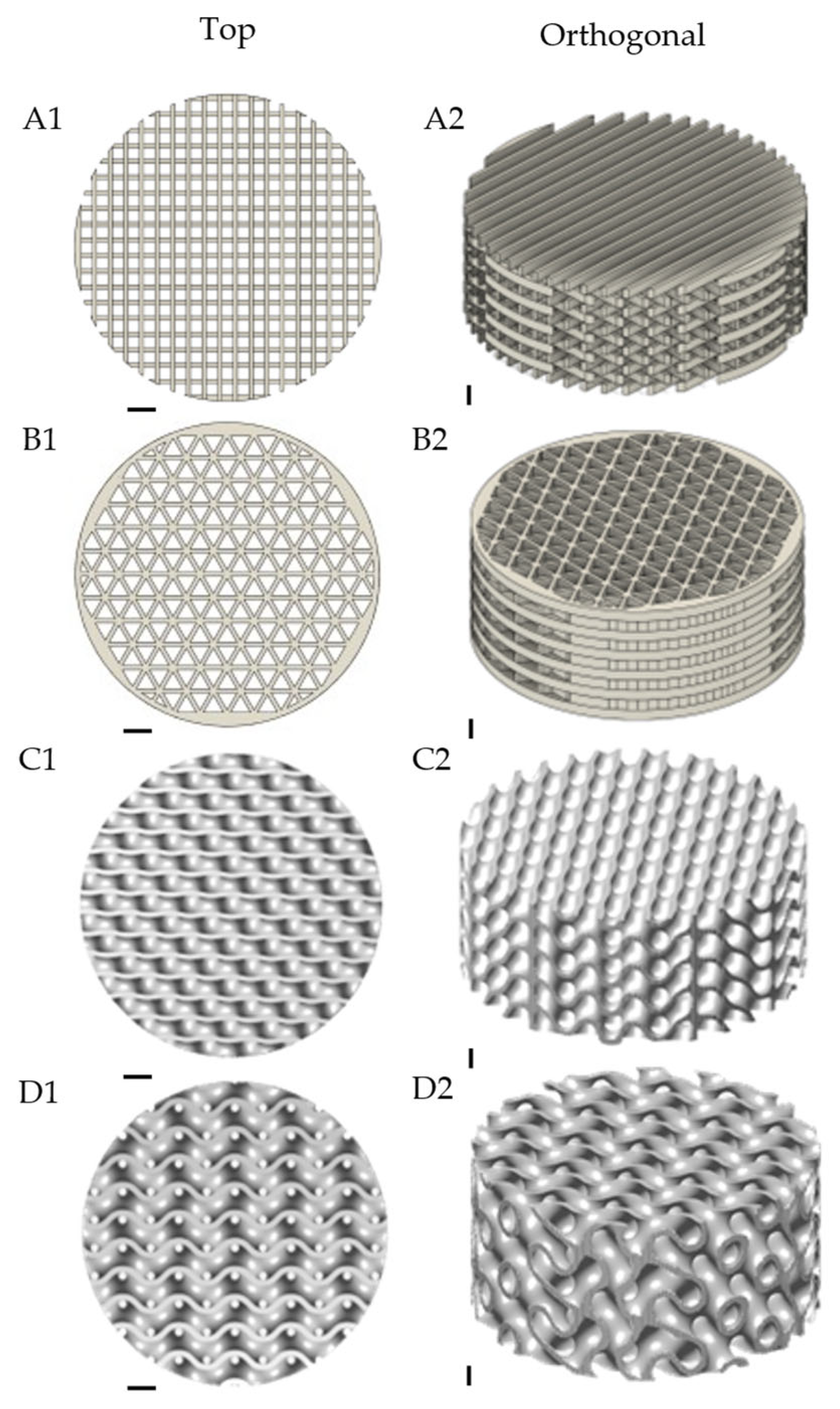
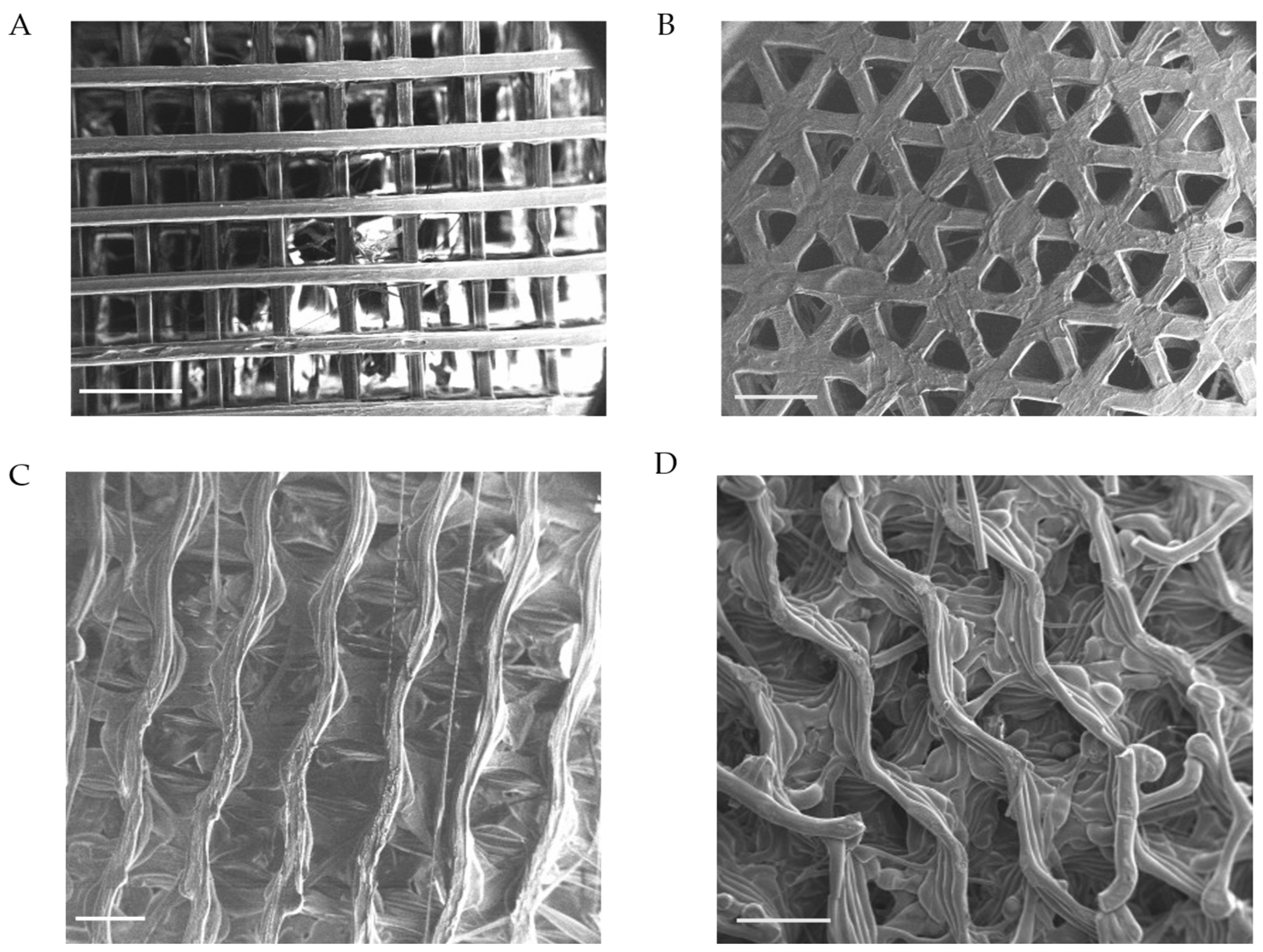

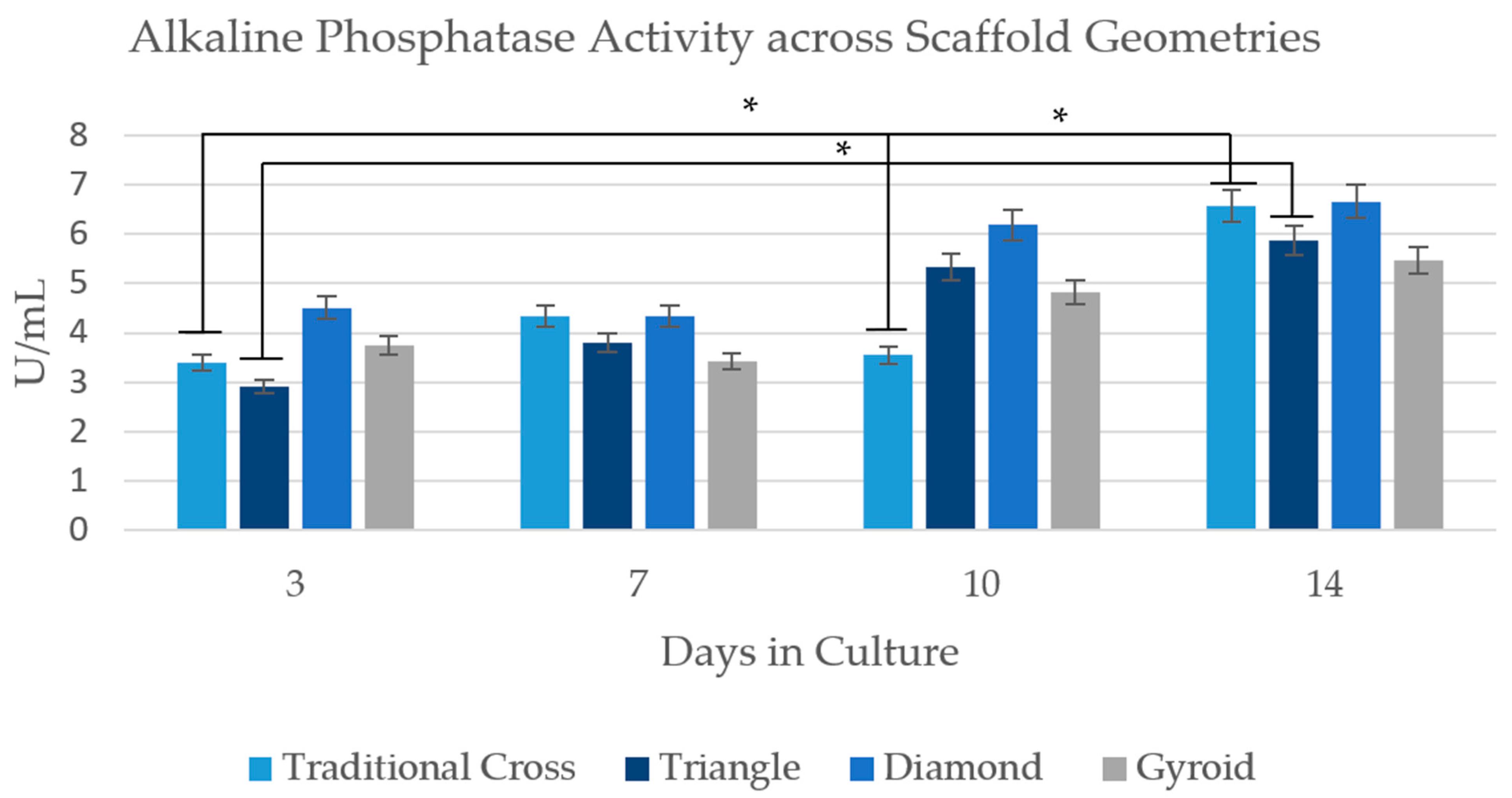

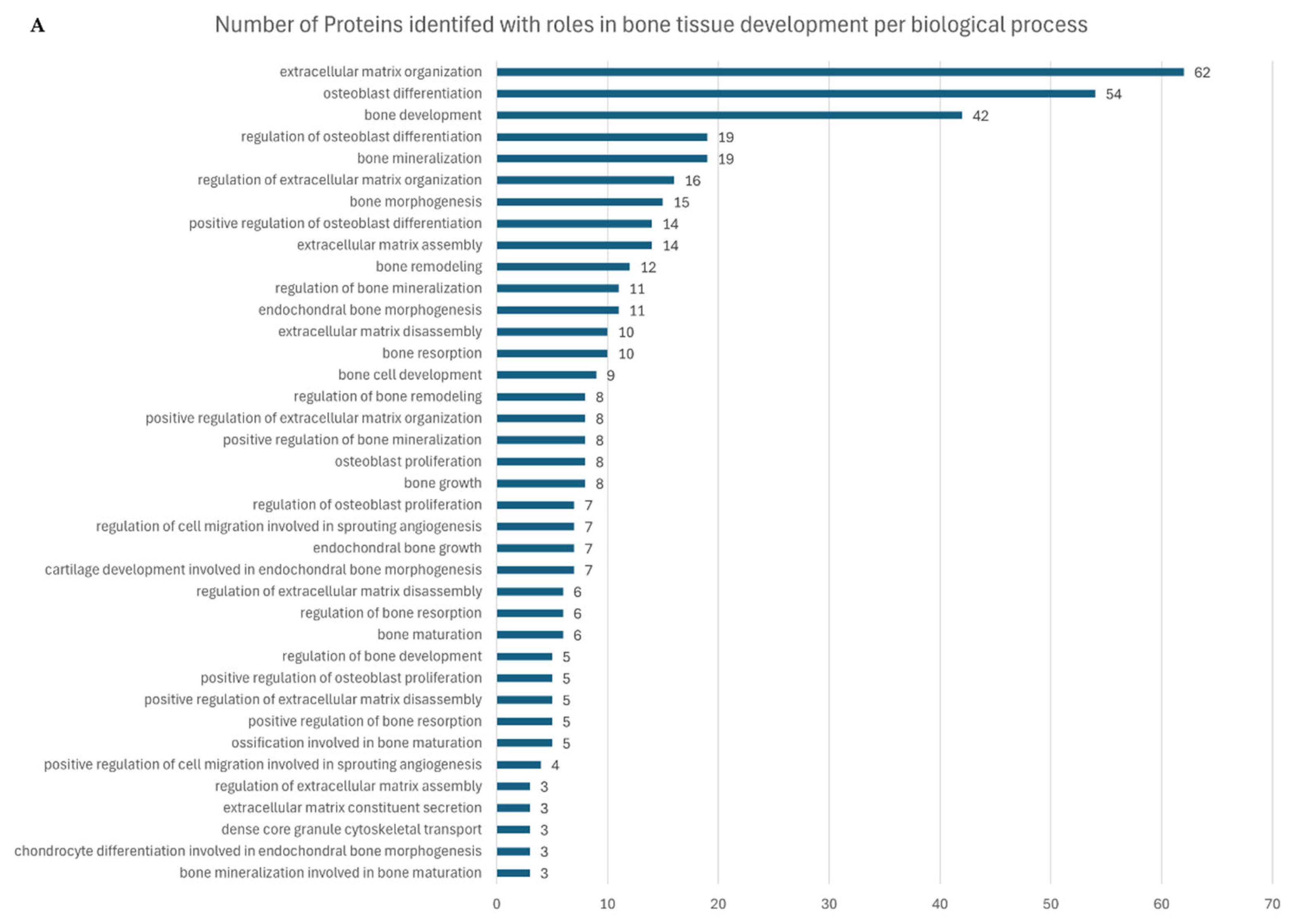
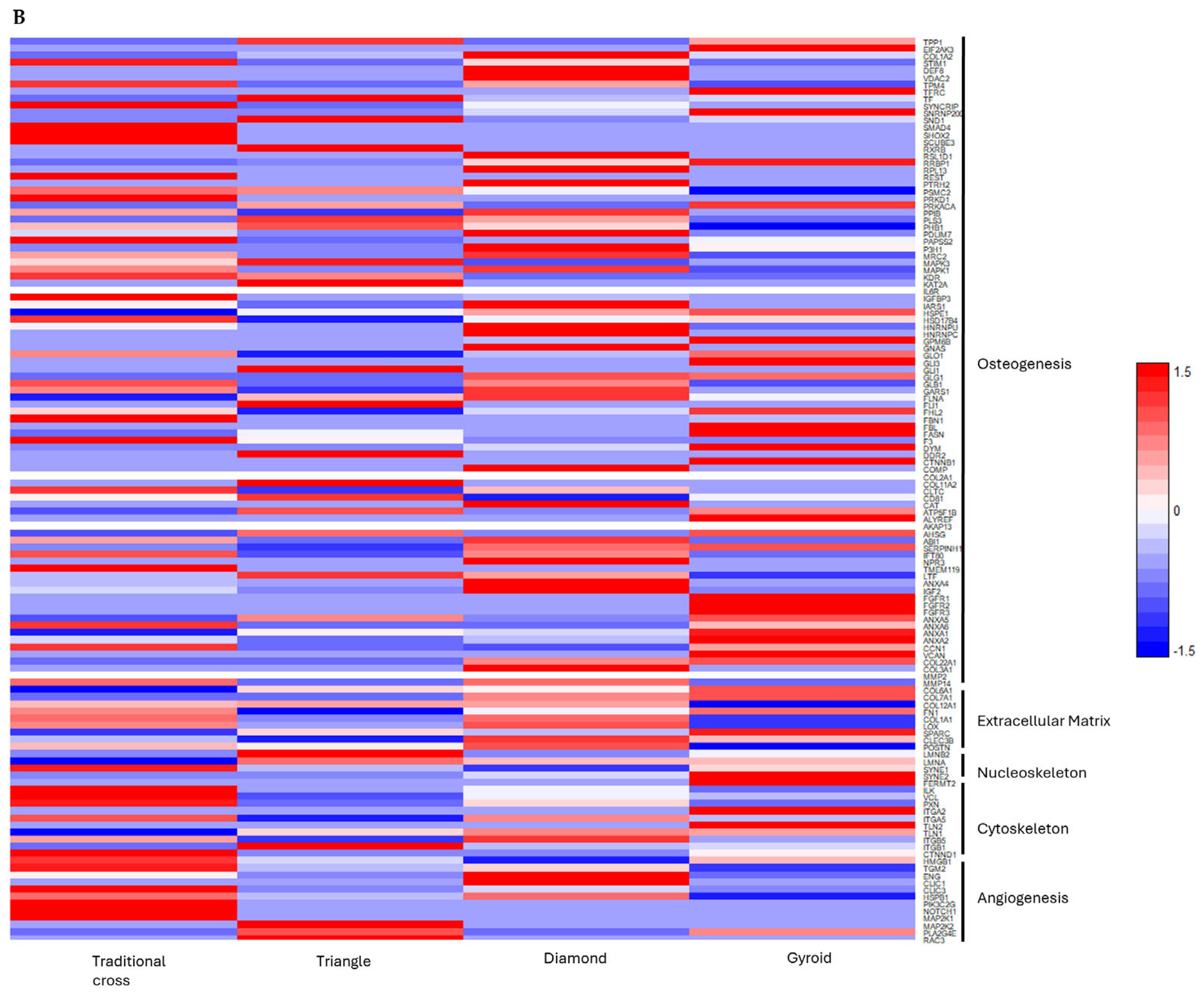
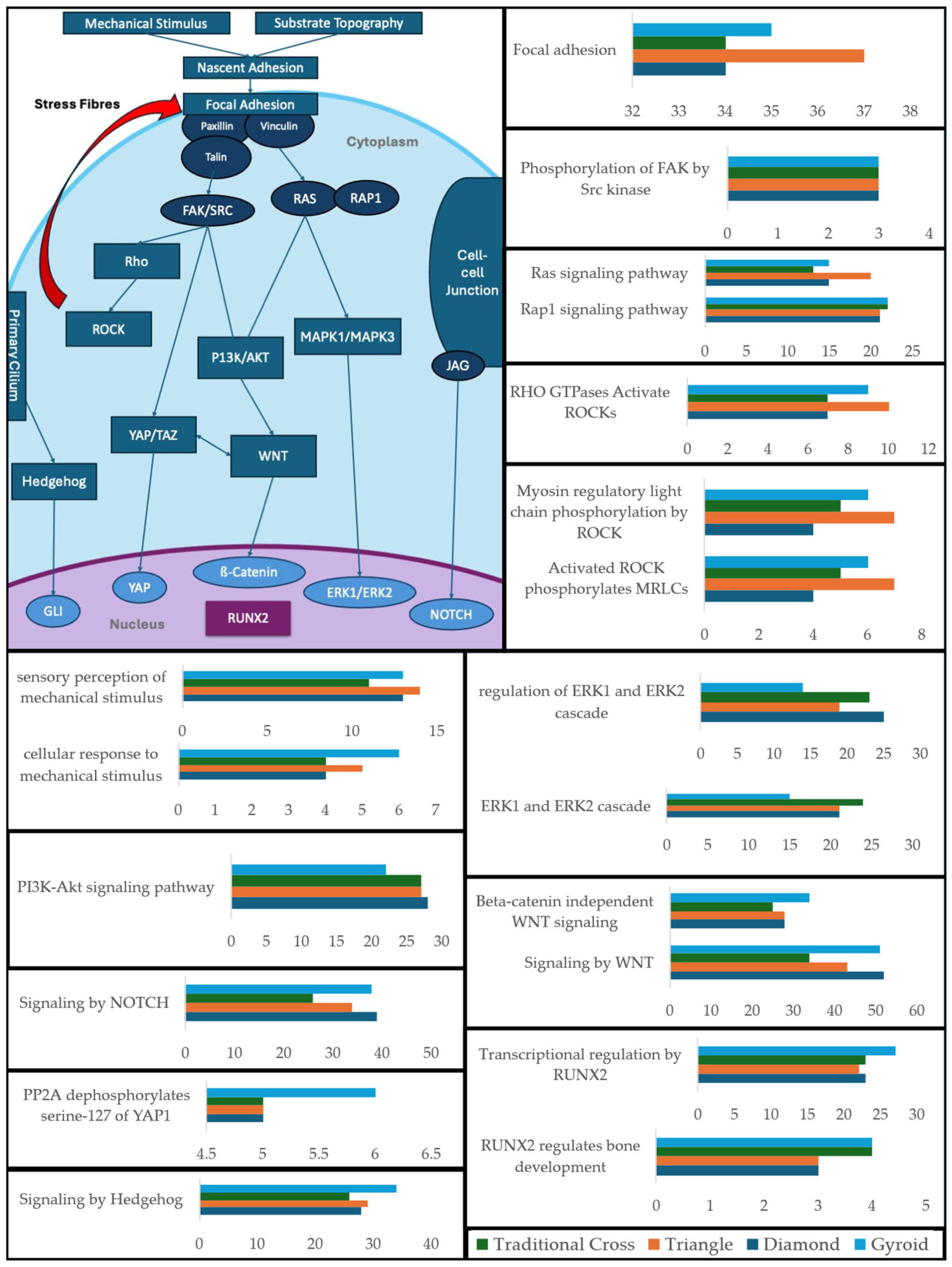
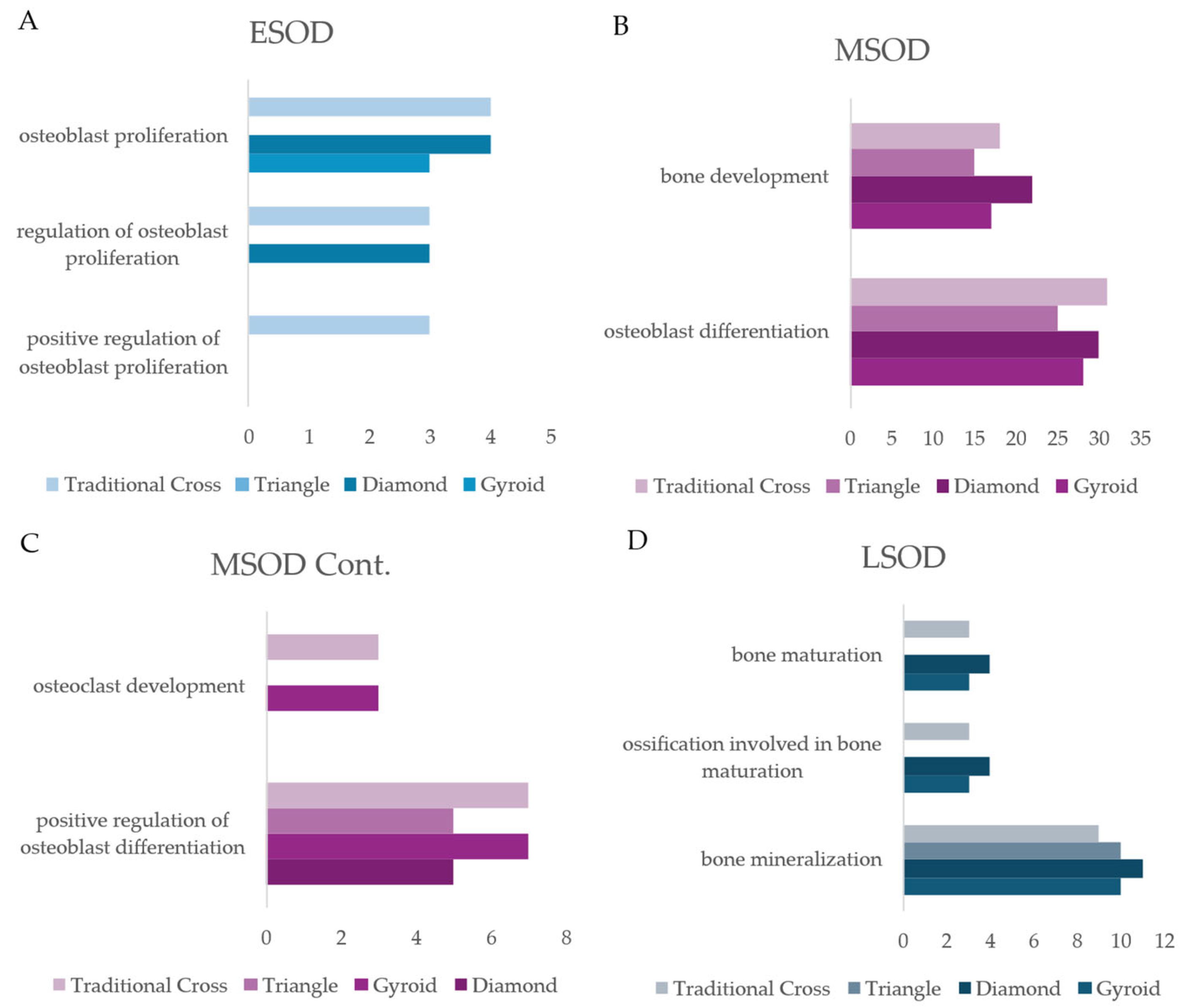
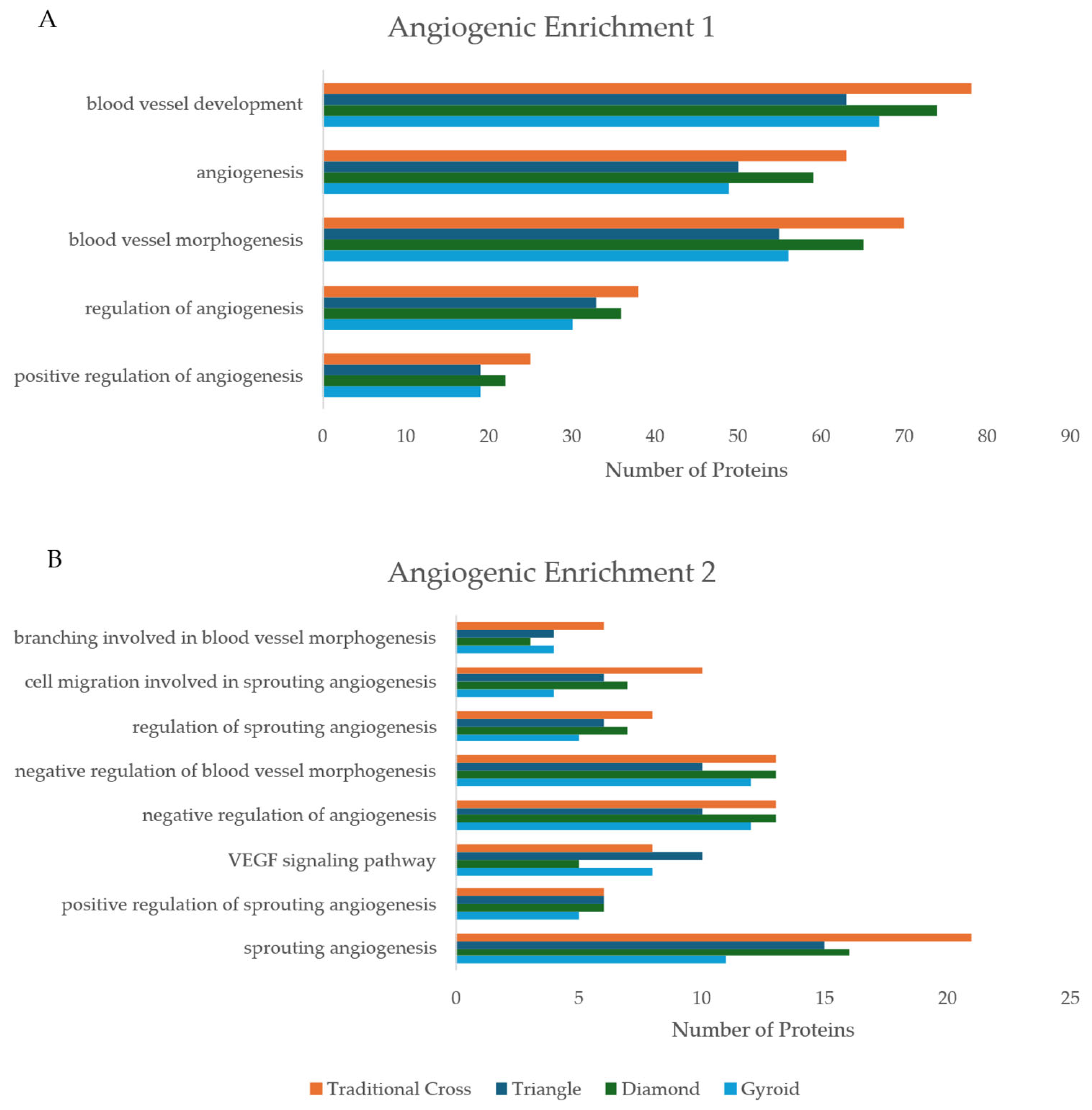
| Traditional Cross | Triangle | Diamond | Gyroid | |
|---|---|---|---|---|
| Total | 1036 | 1241 | 1200 | 1254 |
| Unique | 205 | 194 | 244 | 216 |
| Shared | 831 | 1047 | 956 | 1038 |
| Printing Parameter | Value |
|---|---|
| Layer Height | 0.1 mm |
| Printing Temperature (nozzle) | 200° |
| Bed Temperature | 60° |
| Printing Speed | 100 mm/s |
Disclaimer/Publisher’s Note: The statements, opinions and data contained in all publications are solely those of the individual author(s) and contributor(s) and not of MDPI and/or the editor(s). MDPI and/or the editor(s) disclaim responsibility for any injury to people or property resulting from any ideas, methods, instructions or products referred to in the content. |
© 2025 by the authors. Licensee MDPI, Basel, Switzerland. This article is an open access article distributed under the terms and conditions of the Creative Commons Attribution (CC BY) license (https://creativecommons.org/licenses/by/4.0/).
Share and Cite
Ryan, H.P.; Milthorpe, B.K.; Santos, J. Osteogenic Differentiation of Mesenchymal Stem Cells Induced by Geometric Mechanotransductive 3D-Printed Poly-(L)-Lactic Acid Matrices. Int. J. Mol. Sci. 2025, 26, 7494. https://doi.org/10.3390/ijms26157494
Ryan HP, Milthorpe BK, Santos J. Osteogenic Differentiation of Mesenchymal Stem Cells Induced by Geometric Mechanotransductive 3D-Printed Poly-(L)-Lactic Acid Matrices. International Journal of Molecular Sciences. 2025; 26(15):7494. https://doi.org/10.3390/ijms26157494
Chicago/Turabian StyleRyan, Harrison P., Bruce K. Milthorpe, and Jerran Santos. 2025. "Osteogenic Differentiation of Mesenchymal Stem Cells Induced by Geometric Mechanotransductive 3D-Printed Poly-(L)-Lactic Acid Matrices" International Journal of Molecular Sciences 26, no. 15: 7494. https://doi.org/10.3390/ijms26157494
APA StyleRyan, H. P., Milthorpe, B. K., & Santos, J. (2025). Osteogenic Differentiation of Mesenchymal Stem Cells Induced by Geometric Mechanotransductive 3D-Printed Poly-(L)-Lactic Acid Matrices. International Journal of Molecular Sciences, 26(15), 7494. https://doi.org/10.3390/ijms26157494








